-
01-01-2015
Women’s temporality after cardiac surgery: contributions to nursing care
Revista Brasileira de Enfermagem. 2015;68(6):1056-1062
Abstract
Women’s temporality after cardiac surgery: contributions to nursing care
Revista Brasileira de Enfermagem. 2015;68(6):1056-1062
DOI 10.1590/0034-7167.2015680609i
Views0See moreABSTRACT
Objective:
to unveil women’s existential movement after cardiac surgery.
Method:
qualitative phenomenological study. The research setting was a hospital in Minas Gerais, in which ten women were interviewed between December 2011 and January 2012.
Results:
after hospital discharge, the women experienced physical, social and emotional impairments, and expressed the desire to go back to the time before their diagnosis, because they felt as though they still had heart disease. This vague and average understanding led to three units of meaning that, from a Heideggerian hermeneutic point of view, revealed the phenomenon of cardiac surgery as a present circumstance that limited the participants’ daily lives.
Conclusion:
nurses supporting women patients after cardiac surgery should promote health considering existential facets that are expressed during care. The bases for comprehensive care are revealed in singular and whole meetings of subjectivity.
-
01-01-2015
Compliance of hand hygiene in maintaining the catheter for hemodialysis
Revista Brasileira de Enfermagem. 2015;68(6):1050-1055
Abstract
Compliance of hand hygiene in maintaining the catheter for hemodialysis
Revista Brasileira de Enfermagem. 2015;68(6):1050-1055
DOI 10.1590/0034-7167.2015680608i
Views0See moreABSTRACT
Objective:
to assess the compliance of the practice of hand hygiene in maintaining the temporary double-lumen catheter for hemodialysis, through the use of process indicator at the University Hospital of the University of São Paulo.
Method:
a quantitative, exploratory, descriptive, observational study. Sample consists of 155 observations of patients with catheter from March to November 2011, using the Maintenance Indicator Temporary Dual Lumen Catheter for Hemodialysis.
Results:
the overall compliance rate was 65.8%. Of the 13 specific components evaluated, 9 (69.2%) had 100% compliance. Hand hygiene by health professionals presented one of the worst rates (83.9%).
Conclusion:
it is necessary to implement strategies to reduce the rates of non-compliance, improve quality of care and safety of patients with catheter, and explore factors that affect the process, such as structural issues, and behavioral materials.
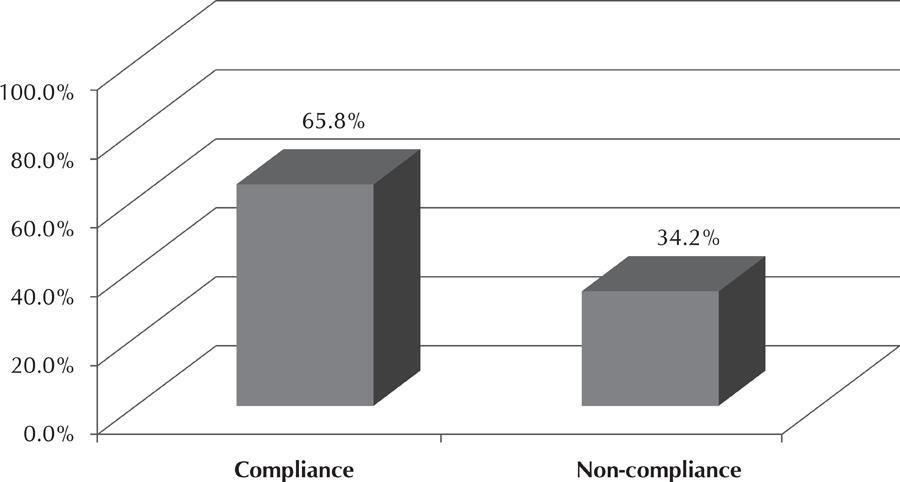
-
01-01-2015
Replication of the training program in nonverbal communication in gerontology
Revista Brasileira de Enfermagem. 2015;68(6):1042-1049
Abstract
Replication of the training program in nonverbal communication in gerontology
Revista Brasileira de Enfermagem. 2015;68(6):1042-1049
DOI 10.1590/0034-7167.2015680607i
Views0See moreABSTRACT
Objective:
to measure the rate of assimilation of applied content at immediate and subsequent moments after a nonverbal communication in gerontology training program.
Method:
descriptive and exploratory fi eld study developed in three state administered hospitals, which attend Brazilian National Health Service (SUS) clients. The duration of the training was twelve hours, applied with 102 healthcare professionals.
Results:
the results revealed that the rate of assimilation of the content immediately after the program was satisfactory, as well as being satisfactory in the aspects concept of aging; strategies to foster the independence and autonomy of the elderly person; communication interferences linked to the elderly and the professional; recognition of non-verbal functions and dimensions. The exception was the professional perception faced with aspects that influence the success of communication.
Conclusion:
it was concluded that the replication of this program was relevant and current for the hospital context, remaining effi cient for healthcare professionals.
-
01-01-2015
Physical and psychological violence against the elderly: prevalence and associated factors
Revista Brasileira de Enfermagem. 2015;68(6):1035-1041
Abstract
Physical and psychological violence against the elderly: prevalence and associated factors
Revista Brasileira de Enfermagem. 2015;68(6):1035-1041
DOI 10.1590/0034-7167.2015680606i
Views0See moreABSTRACT
Objective:
to verify the prevalence and associated factors to physical and psychological violence against elderlies and trace the sociodemographic and clinical indicators of this population.
Method:
household survey conducted in 729 elderlies Uberaba – MG. Data were analyzed by Chi-square test and logistic regression (p < 0,05).
Results:
the prevalence of elderly on violence was 20.9%, and 5.9% to 20.9% for physical and psychological. Among them prevailed women; with 60├80 years; no education; with income, with their partner as the primary aggressor; negative self-perception of health, hospitalization in the last year and presence of multimorbidities. The violence has been associated with have 60├80 years, living with your partner and dependence for instrumental activities of daily living.
Conclusion:
reinforces the need for early identification of domestic violence and invest in both the old protective actions and in maintaining functional capacity and social inclusion.
-
01-01-2015
First civil service examination for nurses at the Administrative Department of Public Service
Revista Brasileira de Enfermagem. 2015;68(6):1027-1034
Abstract
First civil service examination for nurses at the Administrative Department of Public Service
Revista Brasileira de Enfermagem. 2015;68(6):1027-1034
DOI 10.1590/0034-7167.2015680605i
Views0See moreABSTRACT
Objective:
to describe the results of the first national public service examination for nurses conducted by the Administrative Department of Public Service between 1941 and 1942.
Method:
historical-documentary research with a quantitative approach.
Results:
155 candidates registered, aged between 21 and 35 years old, 141 (91%) of whom were female. A total of 120 candidates passed the practical exam. Of these, 116 took the written qualification exam. In the end, 107 were approved, 74 (69.1%) of whom were temporary public nurses, 59 (55.1%) Anna Nery Nursing School alumni, and 10 among the first 20 twenty became involved with the Brazilian Association of Nursing later.
Conclusion:
although the exam legitimized the meritbased culture in the staff selection in the area of Brazilian nursing, egalitarian criteria were mitigated, especially regarding the grades applied to different kinds of exams. This resulted in a significant number of temporary nurses approved.
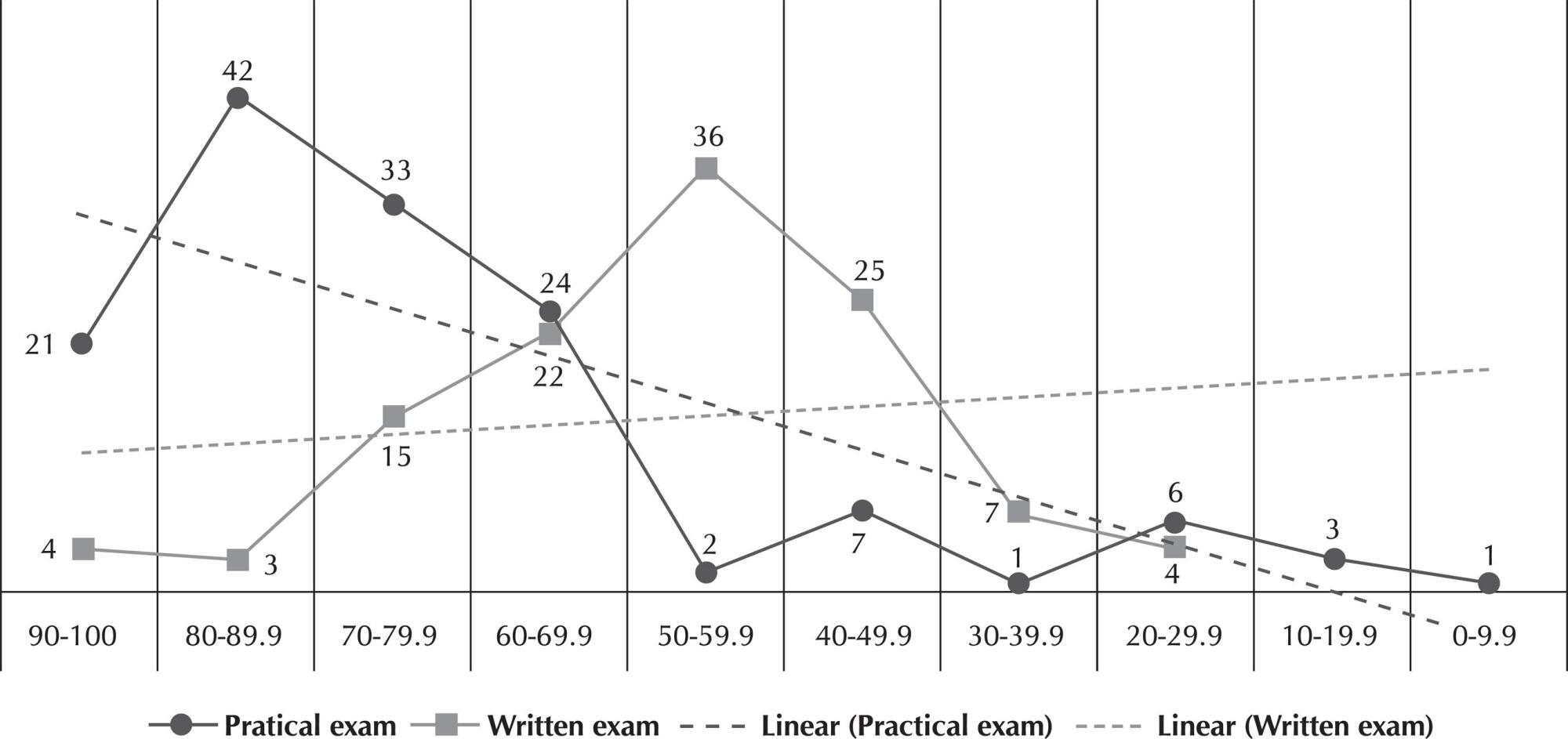
-
01-01-2015
Children and adolescents with chronic kidney disease in haemodialysis: perception of professionals
Revista Brasileira de Enfermagem. 2015;68(6):1020-1026
Abstract
Children and adolescents with chronic kidney disease in haemodialysis: perception of professionals
Revista Brasileira de Enfermagem. 2015;68(6):1020-1026
DOI 10.1590/0034-7167.2015680604i
Views0See moreABSTRACT
Objective:
to identify aspects impacting on quality of life for children and adolescents with chronic kidney disease on hemodialysis, from the perspective of health professionals, as an essential step for the construction of a specific module of the DISABKIDS® instrument.
Method:
methodological study. Data was collected between May and June 2012, through personal interviews with 12 participants, in two dialysis centers. The empirical material was analyzed according to the thematic content analysis, using the program MAXQDA – Qualitative Data Analysis Software.
Results:
we identifi ed seven themes: self-care, family support, impact of diagnosis, expectation of kidney transplant, truancy, socialization and stigma, grouped into three domains.
Conclusion:
the results showed aspects that impact the quality of life of these customers and, therefore, will be considered in the development of specifi c DISABKIDS® module. In addition, these aspects are relevant to the preparation and planning of actions directed towards children and adolescents with chronic kidney disease.
-
01-01-2015
From frustration to coping with caring for death by nurse technicians
Revista Brasileira de Enfermagem. 2015;68(6):1013-1019
Abstract
From frustration to coping with caring for death by nurse technicians
Revista Brasileira de Enfermagem. 2015;68(6):1013-1019
DOI 10.1590/0034-7167.2015680603i
Views0See moreABSTRACT
Objective:
to understand nurse technicians’ experience with caring for the death of terminal patients in ICUs and to configure a theoretical model.
Method:
qualitative study with theoretical saturation when analyzing the 10th non-directive interview, having as reference Grounded Theory, Symbolic Interactionism and Bioethics.
Results:
the core category – from frustration to coping with dignified nursing care for finitude: the acceptance of death as a therapeutic and intervenient component – emerged from the comparison of the sub-processes: when the nurse does not feel prepared for caring for death, accepting death as a therapeutic phenomenon and developing coping strategies.
Conclusion:
according to Symbolic Interactionism, a novice professional’s frustration in caring for an individual for death is related to his/her interaction and interpretation of the situation as he/she feels prepared only to care for individuals for life.
-
01-01-2015
Sedentary lifestyle in individuals with hypertension
Revista Brasileira de Enfermagem. 2015;68(6):1005-1012
Abstract
Sedentary lifestyle in individuals with hypertension
Revista Brasileira de Enfermagem. 2015;68(6):1005-1012
DOI 10.1590/0034-7167.2015680602i
Views0See moreABSTRACT
Objective:
to identify the prevalence of nursing diagnosis Sedentary lifestyle (SL) and to analyze its association with clinical indicators (CI) and related factors (RF) in patients with hypertension.
Method:
cross-sectional study with 285 patients with hypertension at a reference center for outpatient care in Northeastern Brazil. To collect data it was used an instrument based on operational defi nitions of the CI and RF previously validated. Four nurses rated SL as present or absent. To evaluate the association between CI and RF with the presence of SL it was applied the chi-square test. The prevalence ratio and confi dence interval was calculated to verify the magnitude of the effect between RF and SL. Results: SL was identifi ed in 55.8% of the sample. Five IC and six RF showed a signifi cant association with SL.
Conclusion:
the study identifi es main indicators for inference of SL as well as their possible causal factors among people with hypertension.
-
ORIGINAL ARTICLE04-09-2020
Factors associated with the discontinuance of outpatient follow-up in neonatal units
Revista Brasileira de Enfermagem. 2020;73(3):e20180793
Abstract
ORIGINAL ARTICLEFactors associated with the discontinuance of outpatient follow-up in neonatal units
Revista Brasileira de Enfermagem. 2020;73(3):e20180793
DOI 10.1590/0034-7167-2018-0793
Views1See moreABSTRACT
Objectives:
to identify predisposing and enabling factors as well as the health needs associated with the discontinuance of outpatient follow-up of newborns who were hospitalized at neonatal intensive care unit.
Methods:
cross-sectional study, using the behavioral model of health services use. The study was composed of 358 mothers and newborns referred to the outpatient follow-up after discharge. Characterization, perception of social support, postnatal depression, and attendance to appointments data were collected, analyzed by the R software (3.3.1).
Results:
outpatient follow-up was discontinued by 31.28% of children in the first year after discharge. In multiple regression analysis, the chance of discontinuance was higher for newborns who used mechanical ventilation (OR = 1.68; 95%CI 1.04-2.72) and depended on technology (OR = 3.54; 95%CI 1.32-9.5).
Conclusions:
predisposing factors were associated with the discontinuance of follow-up; enabling factors and health needs did not present a significant association. Children with more complex health conditions require additional support to participate in follow-up programs, thus ensuring the continuity of care.

-
ERRATUM02-26-2024
ERRATUM
Revista Brasileira de Enfermagem. 2024;77(1):e20160061
Abstract
ERRATUMERRATUM
Revista Brasileira de Enfermagem. 2024;77(1):e20160061
DOI 10.1590/0034-7167.20247701e03
Views2In the article “Nurses in the labor market: professional insertion, competencies and skills”, with DOI number: , published in Revista Brasileira de Enfermagem, 2017;70(6):1220-6, on page 1225:Include before REFERENCES:[…]See more -
REVIEW12-08-2024
Interventions for Strengthening General Self-Efficacy Beliefs in College Students: An Integrative Review
Revista Brasileira de Enfermagem. 2024;77(1):e20230192
Abstract
REVIEWInterventions for Strengthening General Self-Efficacy Beliefs in College Students: An Integrative Review
Revista Brasileira de Enfermagem. 2024;77(1):e20230192
DOI 10.1590/0034-7167-2023-0192
Views0See moreABSTRACT
Objective:
To assess the evidence regarding the effectiveness of interventions aimed at strengthening self-efficacy beliefs in college students.
Methods:
Integrative Review conducted on the Lilacs, PubMed, CinahL, Cochrane Collaboration Databases, Scopus, and PsycInfo databases. The methodological quality of the studies was assessed using tools proposed by the Joanna Briggs Institute, and the results were analyzed descriptively.
Results:
Out of the 10 selected studies, six demonstrated that interventions aimed at strengthening self-efficacy were effective (Levels of Evidence II and III), and four revealed contrary results (Levels of Evidence I and II). Programs aimed at enhancing self-efficacy should include content on positive mental health, psychoeducation strategies, cover a period of eight to twelve weeks, and consider the completion of homework assignments.
Conclusion:
The synthesis of evidence pointed to pathways for building an effective self-efficacy strengthening program to be implemented in universities.
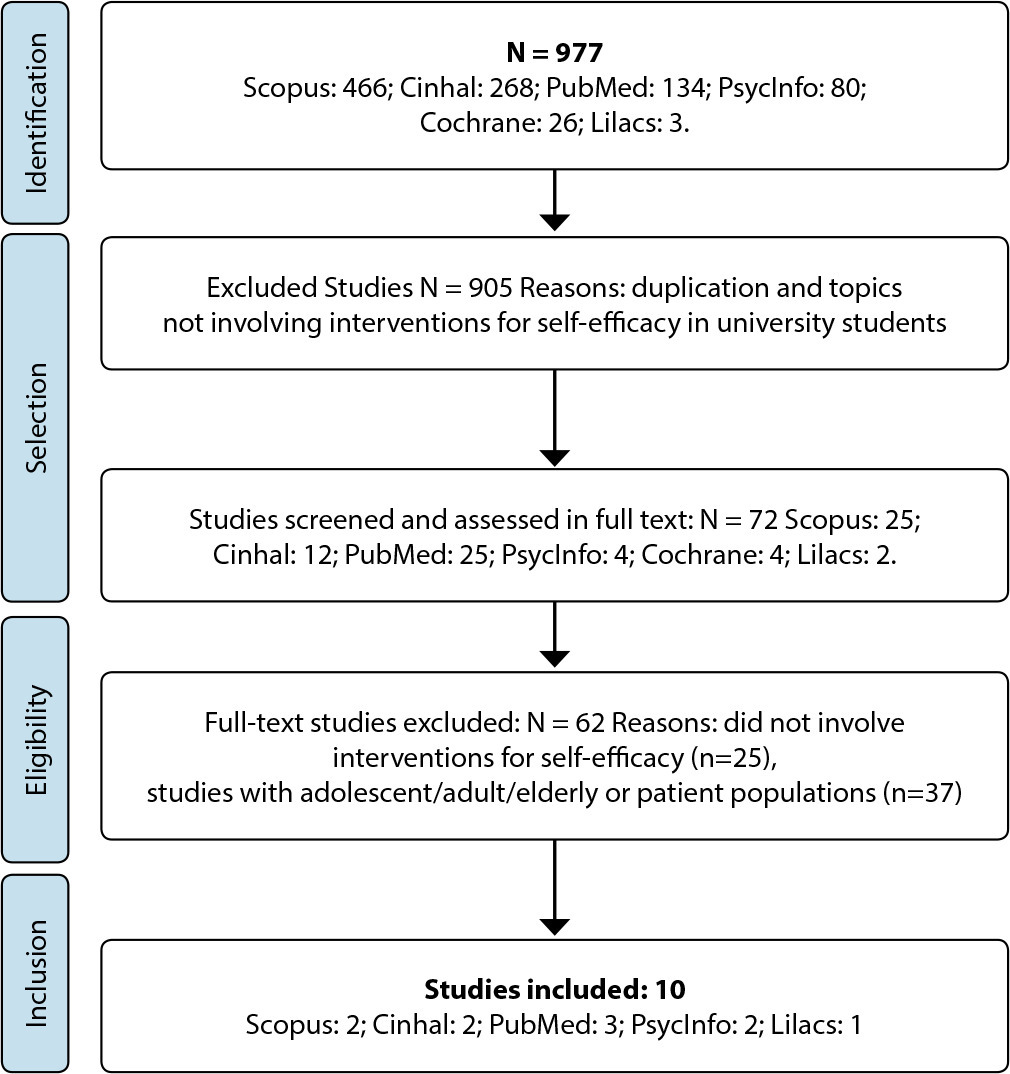
-
ORIGINAL ARTICLE05-13-2024
Generalized Resistance Deficits in inmates with hypertension: missing resources that limit health
Revista Brasileira de Enfermagem. 2024;77(2):e20230246
Abstract
ORIGINAL ARTICLEGeneralized Resistance Deficits in inmates with hypertension: missing resources that limit health
Revista Brasileira de Enfermagem. 2024;77(2):e20230246
DOI 10.1590/0034-7167-2023-0246
Views0See moreABSTRACT
Objective:
to understand the Generalized Resistance Deficits of people deprived of liberty with hypertension in a Brazilian prison unit.
Method:
qualitative research, anchored in Salutogenesis, carried out with 38 people with hypertension from a Brazilian prison unit, from February to July 2022, with a semi-structured interview with open-ended questions, whose analysis was thematic, explaining the limitations to health in prison.
Results:
13 Generalized Resistance Deficits were reported, mostly related to the prison environment and, to a lesser extent, to the social group and the individual, respectively. Living in prison for people with hypertension implies living with a high number of Generalized Resistance Deficits, accentuating the movement towards the disease pole.
Final considerations:
knowing Generalized Resistance Deficits allows directing health promotion to support the use of available Generalized Resistance Resources and contributes to the expansion of intersectoral policies.
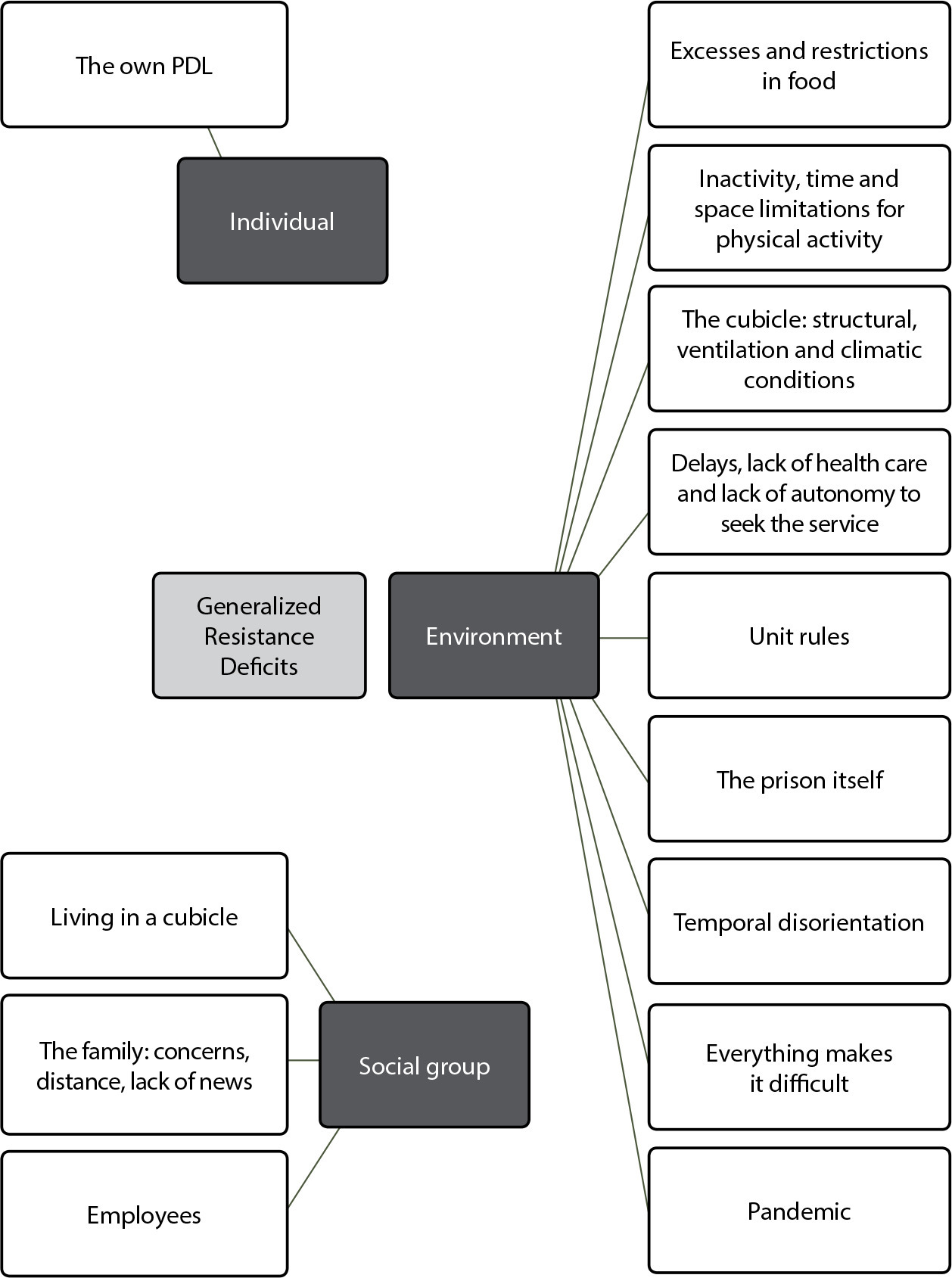
-
ERRATUM06-14-2024
ERRATUM
Revista Brasileira de Enfermagem. 2024;77(2):e2024n2e05
Abstract
ERRATUMERRATUM
Revista Brasileira de Enfermagem. 2024;77(2):e2024n2e05
DOI 10.1590/0034-7167.20247702e05
Views2In the article “Educational technologies used to promote self-care for people with diabetes mellitus: integrative review”, with DOI number: , published in Revista Brasileira de Enfermagem, 2023;76(Suppl 4):e20230049, in the title:Where it read:[…]See more -
ERRATUM06-14-2024
ERRATUM
Revista Brasileira de Enfermagem. 2024;77(2):e2024n2e06
Abstract
ERRATUMERRATUM
Revista Brasileira de Enfermagem. 2024;77(2):e2024n2e06
DOI 10.1590/0034-7167.20247702e06
Views2In the article “Is there scientific relevance to the plot of films and documentaries about eating disorders?”, with DOI number: , published in Revista Brasileira de Enfermagem, 2024;77(1):e20220547, page 7:Where it read:[…]See more -
REVIEW07-29-2024
Profile of scientific production on nursing technology construction, validity and application: a bibliometric study
Revista Brasileira de Enfermagem. 2024;77(3):e20230452
Abstract
REVIEWProfile of scientific production on nursing technology construction, validity and application: a bibliometric study
Revista Brasileira de Enfermagem. 2024;77(3):e20230452
DOI 10.1590/0034-7167-2023-0452
Views1See moreABSTRACT
Objective:
to analyze the profile of scientific production on nursing technology construction, validity and application.
Methods:
this is a bibliometric study, carried out in six databases, based on the Methodi Ordinatio application, arranged in nine stages. To represent the findings, the VOSviewer® software was used.
Results:
346 studies were identified, obtained from BDENF, CINAHL, EMBASE, LILACS, PubMed/MEDLINE, Scopus and Web of Science. There was a predominance of the English language, and 20% of the authors hold more than 25% of studies. Only two journals account for 25% of studies in the period studied. Twenty-six studies were selected for the InOrdinatio classification. Nursing Process (23%) stood out among the studies. The most produced technology was software (27%), and 50% of works describe construction and validity.
Conclusions:
there is an emphasis on the creation of educational technologies, especially information technology. The data demonstrates opportunities for future research in the area.

-
ORIGINAL ARTICLE01-10-2024
Inventory of ethical problems in mobile pre-hospital care
Revista Brasileira de Enfermagem. 2024;77:e20230539
Abstract
ORIGINAL ARTICLEInventory of ethical problems in mobile pre-hospital care
Revista Brasileira de Enfermagem. 2024;77:e20230539
DOI 10.1590/0034-7167-2023-0539
Views1See moreABSTRACT
Objective:
to construct and validate the content of an inventory of ethical problems experienced by nurses in mobile pre-hospital care.
Method:
a psychometric approach study, developed with the following stages: (1) instrument construction through a theoretical matrix based on deliberative bioethics, scoping review and online qualitative research; (2) content validity by judges; (3) pre-testing with Mobile Emergency Care Service nurses in various Brazilian states. For content validity analysis, the Content Validity Ratio was calculated (CVR>0.45 for judges and CVR>0.35 for the target population).
Results:
the instrument had 44 items, distributed across four dimensions.
Final considerations:
the constructed instrument presented sources of evidence of content validity, providing good psychometric measurements and constituting a useful tool for nurses’ practice in the pre-hospital setting.
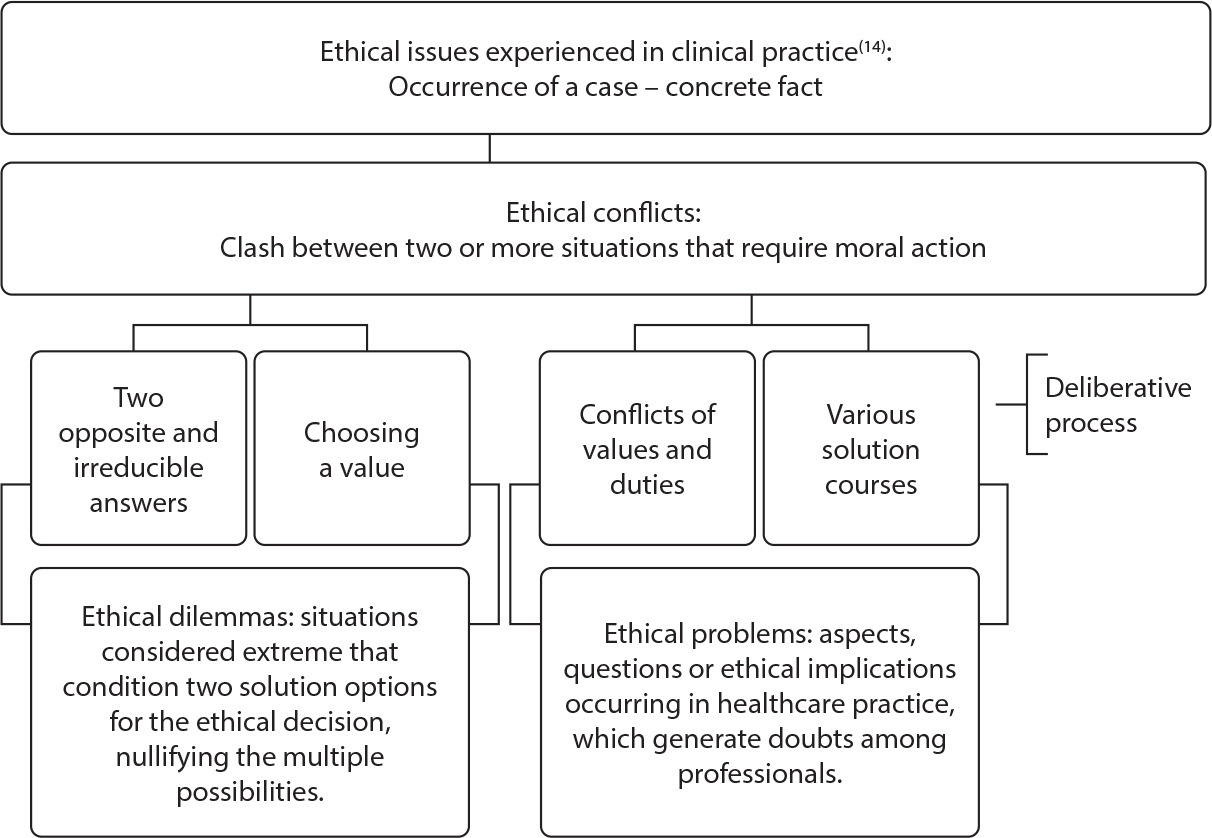
-
REVIEW12-21-2020
Lean Six Sigma methodology application in health care settings: an integrative review
Revista Brasileira de Enfermagem. 2020;73:e20190861
Abstract
REVIEWLean Six Sigma methodology application in health care settings: an integrative review
Revista Brasileira de Enfermagem. 2020;73:e20190861
DOI 10.1590/0034-7167-2019-0861
Views0See moreABSTRACT
Objective:
to analyze the scientific production on the results of Lean Six Sigma methodology in health care institutions.
Methods:
an integrative literature review, with the following question: what are the results in health institutions using Lean Six Sigma and Six Sigma methodology? The search was carried out at MEDLINE, LILACS, BDENF, CINAHL, Web of Science, and Scopus, with no time frame.
Results:
thirty-four articles were included, published between 2005 and 2019, of which 52.9% came from the United States of America. The most commonly found improvements were in hospital institutions and from the perspective of customers and internal processes.
Conclusion:
using Lean Six Sigma methodology proved to be effective in the different health care settings, evidencing a gap in its application regarding people engagement and training.
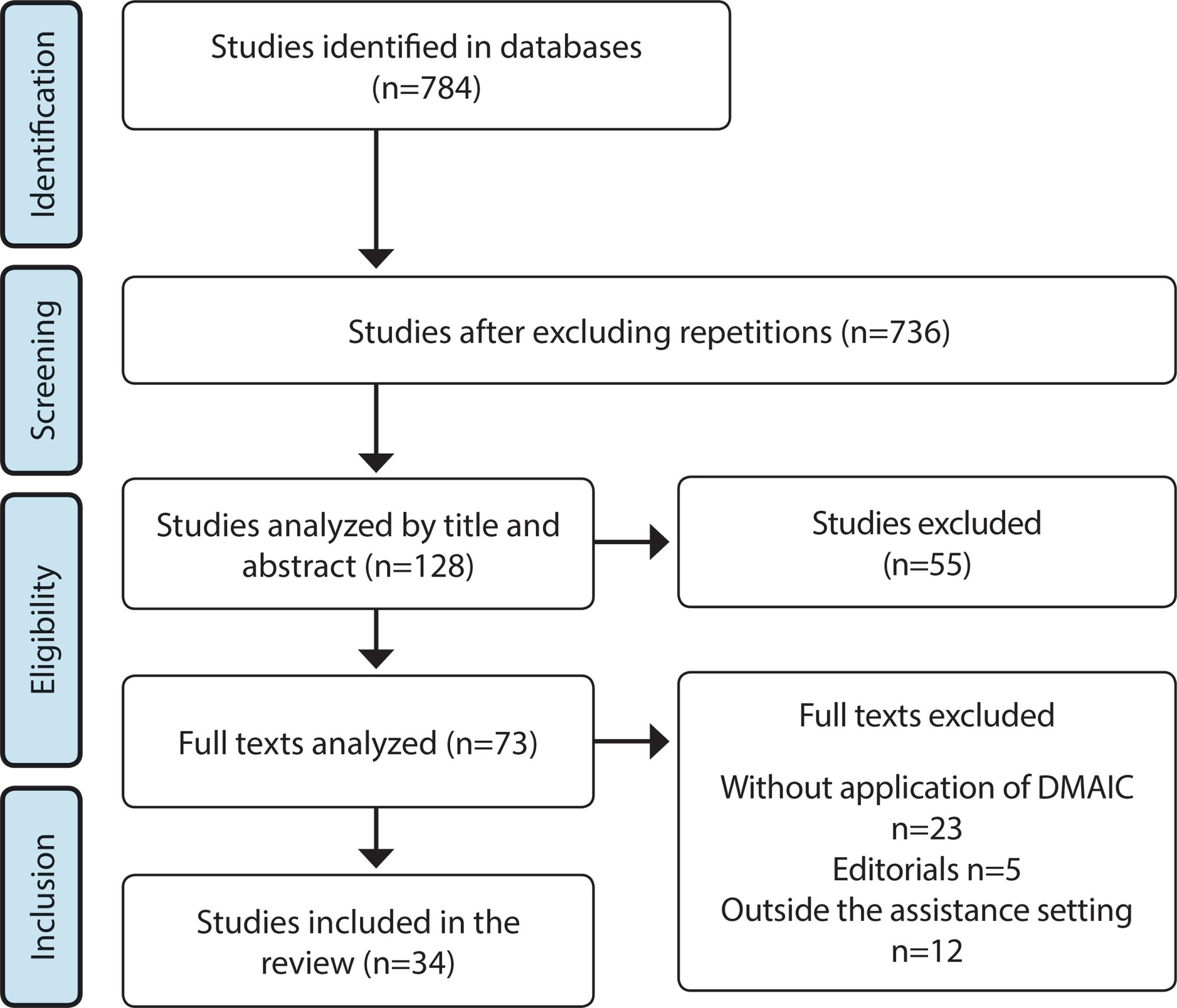
-
REFLECTION06-29-2020
Recommendations in covid-19 times: a view for home care
Revista Brasileira de Enfermagem. 2020;73:e20200310
Abstract
REFLECTIONRecommendations in covid-19 times: a view for home care
Revista Brasileira de Enfermagem. 2020;73:e20200310
DOI 10.1590/0034-7167-2020-0310
Views0See moreABSTRACT
Objective:
To suggest recommendations for the practice of Home Nursing in the context of COVID-19.
Method:
Reflective study, originated from readings associated with the theme, available in current guidelines from the Pan American Health Organization, World Health Organization and the Ministry of Health.
Results:
Recommendations were developed from current scientific evidence for prevention of infections, control of epidemics and pandemics in the Brazilian home scenario.
Final considerations:
the reflections achieved contribute to guiding actions for better assistance to the patient, family caregivers and the community in the perspective of safe home care with COVID-19, and it is characterized as an introductory discussion on the theme, encouraging new studies to be carried out from the unfolding of the current scenario.
-
ORIGINAL ARTICLE06-16-2021
Patient participation in care safety: Primary Health Care professionals’ perception
Revista Brasileira de Enfermagem. 2021;74(2):e20200773
Abstract
ORIGINAL ARTICLEPatient participation in care safety: Primary Health Care professionals’ perception
Revista Brasileira de Enfermagem. 2021;74(2):e20200773
DOI 10.1590/0034-7167-2020-0773
Views0See moreABSTRACT
Objectives:
to analyze health professionals’ perception about the meaning and practice of patient involvement in care safety in Primary Health Care.
Methods:
this is an exploratory, qualitative study, developed with 22 professionals in the Federal District, Brazil. A semi-structured interview was conducted between October and November/2018. Content analysis was carried out according to Bardin.
Results:
nurses, physicians, dentists, among others, participated. The following categories emerged: Meaning of patient involvement in care safety; Factors intervening in patient involvement in care safety; Strategies for patient involvement in care safety; Qualification for patient involvement in care safety.
Final Considerations:
the meaning of patient involvement for care safety was associated with co-responsibility and patient-centered care. Professionals’ practice revealed intervening factors and the use of involvement strategies. A gap was identified in training on patient involvement in care safety.
-
REVIEW03-30-2020
Nursing care in mental health based on the TIDAL MODEL: an integrative review
Revista Brasileira de Enfermagem. 2020;73(2):e20180177
Abstract
REVIEWNursing care in mental health based on the TIDAL MODEL: an integrative review
Revista Brasileira de Enfermagem. 2020;73(2):e20180177
DOI 10.1590/0034-7167-2018-0177
Views0See moreABSTRACT
Objectives:
to identify the applicability of the Phil Barker’s Tidal Model in mental health nursing care.
Methods:
an integrative literature review carried out by LILACS, MEDLINE, Scopus and Web of Science. Data were collected from December 2017 to March 2018. After selecting the studies, the sample totaled 24 articles.
Results:
the articles are in English (91.7%), were published in nursing journals (87.5%), are reflective and/or theoretical (50%) and have level of evidence VII (79.2%). The model brings contributions to nursing science, enabling person-centered care, with an emphasis on interdisciplinary work, nurses’ protagonism and the empowerment of subjects in mental suffering.
Final considerations:
the use of the Tidal Model enables changes in nurses practice working in the context of mental health. Its application by nurses who work in mental health services in Brazil is recommended.

-
ORIGINAL ARTICLE12-05-2019
Perception of body image and nutritional status in adolescents of public schools
Revista Brasileira de Enfermagem. 2019;72:229-235
Abstract
ORIGINAL ARTICLEPerception of body image and nutritional status in adolescents of public schools
Revista Brasileira de Enfermagem. 2019;72:229-235
DOI 10.1590/0034-7167-2018-0644
Views0See moreABSTRACT
Objective:
To assess body image dissatisfaction among adolescents from Northern Minas Gerais.
Method:
This is a cross-sectional study with adolescents of both sexes, enrolled in the sixth to ninth year in the municipal public education network. A questionnaire was used, composed of sociodemographic and body image variables, which was obtained through a scale of silhouette figures. The anthropometric measurements of weight and height were performed to estimate body mass index. The correlation between the classification of the body mass index and the body image of adolescents was estimated through weighted Kappa.
Results:
A total of 535 adolescents participated, and 24.5% had different classifications between the real and ideal body image. The Kappa index for the classification of body image was 0.51, 0.58 and 0.32 for the total of adolescents, girls and boys, respectively.
Conclusion:
Public school adolescents are dissatisfied with their self-body image.
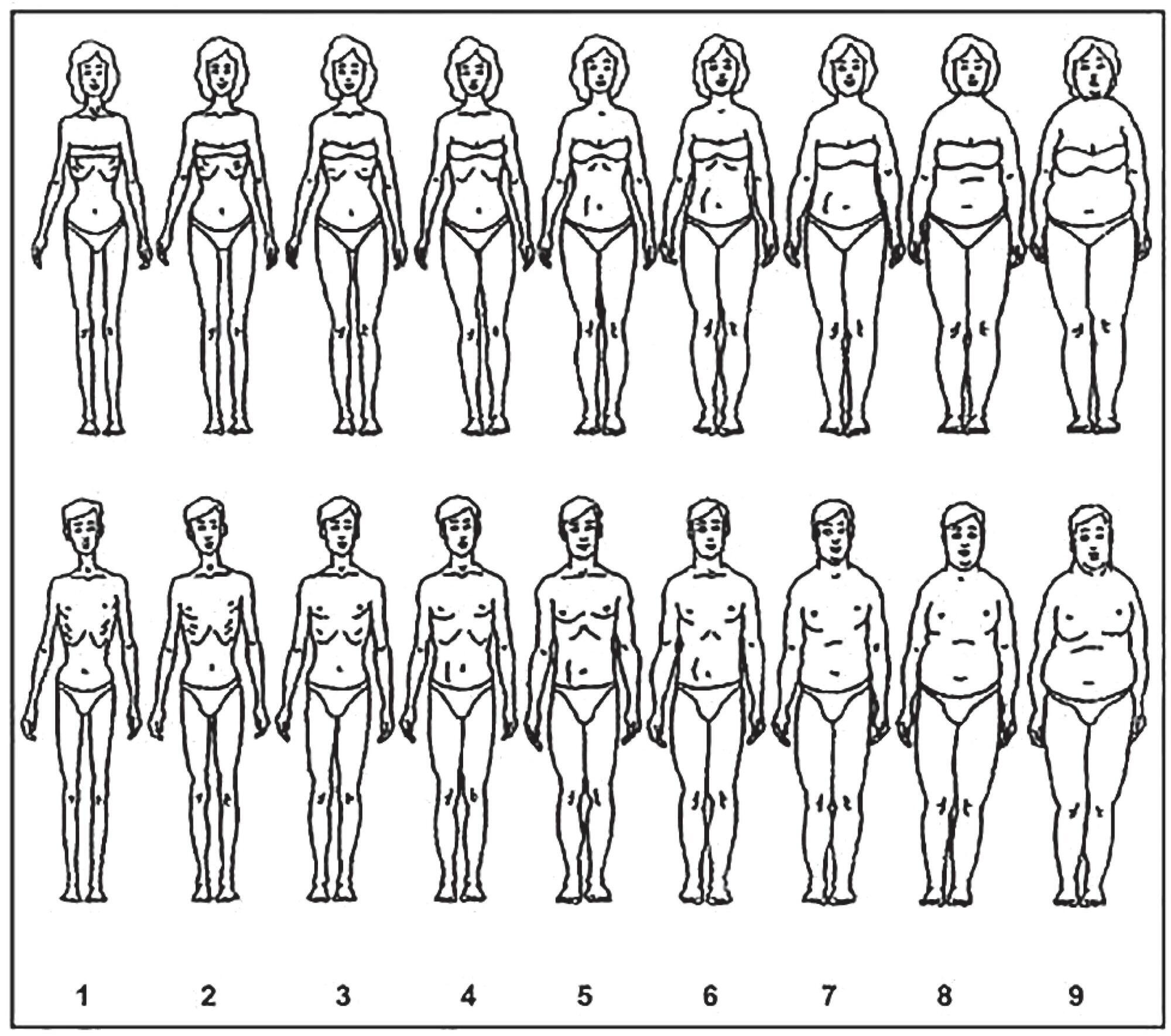
-
04-14-2021
Child behavior during the social distancing in the COVID-19 pandemic
Revista Brasileira de Enfermagem. 2021;74:e20200762
Abstract
Child behavior during the social distancing in the COVID-19 pandemic
Revista Brasileira de Enfermagem. 2021;74:e20200762
DOI 10.1590/0034-7167-2020-0762
Views0See moreABSTRACT
Objective:
To describe the daily activities performed by children from 6 to 12 years of age incomplete and analyze children’s behavior during social distancing in the face of the COVID-19 pandemic.
Methods:
Cross-sectional study with children in a learning stage living in Brazil. The data were collected via online form. Fisher’s exact test was applied to analyze the association of categorical variables with child behavior; when significant, it was used the odds ratio. It was considered results considered statistically significant those presenting values of p < 0.05.
Results:
Data from 530 children were analyzed: 50.3% female, 71.3% from the Southeast Region, 73% in fulltime social distancing, 52% presented anxiety, which was significantly associated with changes in sleep and appetite.
Conclusion:
The results indicate the need for parents/caretakers to stimulate moments for the child to express themselves, not minimizing their feelings and providing emotional support to mitigate the negative impact of these feelings on the child’s mental and physical health.
-
04-14-2021
Emotional labor of nurses in the front line against the COVID-19 pandemic
Revista Brasileira de Enfermagem. 2021;74:e20200660
Abstract
Emotional labor of nurses in the front line against the COVID-19 pandemic
Revista Brasileira de Enfermagem. 2021;74:e20200660
DOI 10.1590/0034-7167-2020-0660
Views1See moreABSTRACT
Objective:
To analyze nurses’ experiences in the front line of the fight against the COVID-19 pandemic regarding the performance of emotional labor (EL), aiming at its characterization and identification of support strategies and development opportunities of nurses and practices.
Methods:
Qualitative, descriptive, and exploratory study, with content analysis of eleven written narratives and reports from a focus group composed of nurses with experience in caring for patients with COVID-19 from different Hospital Centers in Lisbon, Portugal.
Results:
Five themes were extracted: 1) Challenges experienced by nurses in the frontline; 2) Emotions experienced by nurses in service care; 3) Emotional responses of nurses and patients: impact on care; 4) EL of nurses in the patient care process; 5) Opportunities for development in the face of the emotional challenge required of nurses in combating COVID-19.
Final considerations:
The nurses demonstrated the ability to transform this profoundly emotional experience positively.
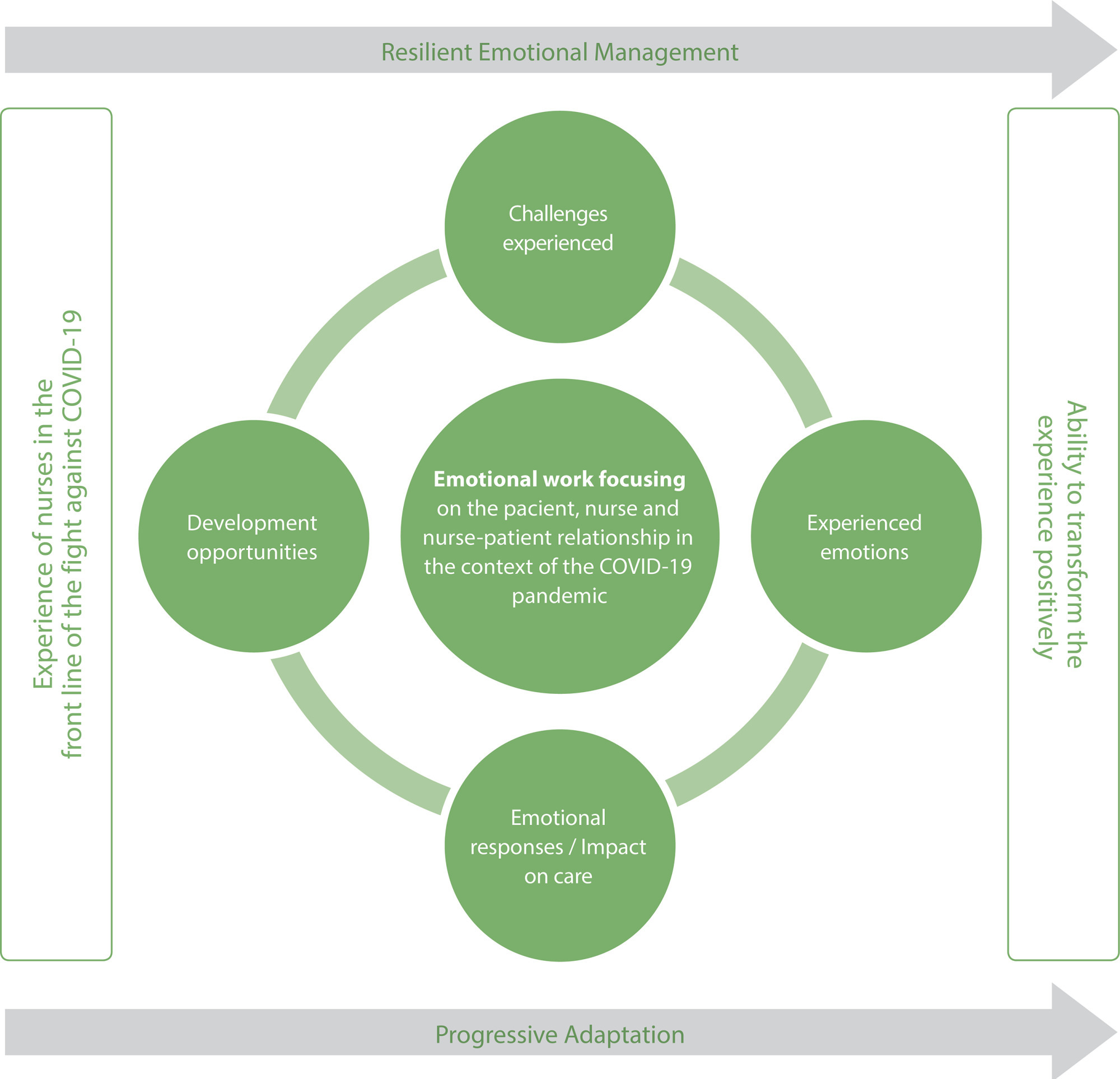
-
ORIGINAL ARTICLE10-19-2020
Factors associated with suicide risk among nurses and physicians: a cross-section study
Revista Brasileira de Enfermagem. 2020;73:e20200352
Abstract
ORIGINAL ARTICLEFactors associated with suicide risk among nurses and physicians: a cross-section study
Revista Brasileira de Enfermagem. 2020;73:e20200352
DOI 10.1590/0034-7167-2020-0352
Views1See moreABSTRACT
Objective:
to estimate the prevalence and factors associated with suicide risk among nurses and physicians.
Method:
a cross-sectional study carried out at a university hospital with 216 health professionals, who answered a socio-demographic-labor questionnaire, the Mini International Neuropsychiatric Interview (MINI) for assessing suicide risk, and the Depression, Anxiety and Stress Scale (DASS 21). The Poisson Regression Model was used for multiple analysis.
Results:
it was identified that variables such as not having a partner, history of attempted suicide, stress and depression symptoms were statistically associated with suicide risk. The prevalence of lifelong suicide attempts among nurses was 9.41%, and among physicians, 2.29%.
Conclusion:
the findings of this investigation enable the understanding of suicidal behavior among hospital nurses and physicians, in addition to enabling the development of prevention strategies in order to reduce suicide risk prevalence in this population group.
Search
Search in:
Nuvem de Tags
Adolescente (85) Atenção Primária à Saúde (239) COVID-19 (91) Criança (91) Cuidados de Enfermagem (269) Educação em Enfermagem (151) Educação em Saúde (139) Enfermagem (930) Enfermagem Pediátrica (86) Estudantes de Enfermagem (77) Estudos de Validação (131) Família (87) Idoso (208) Promoção da Saúde (99) Qualidade de Vida (104) Saúde do Trabalhador (86) Saúde Mental (145) Saúde Pública (82) Segurança do Paciente (150) Tecnologia Educacional (100)



